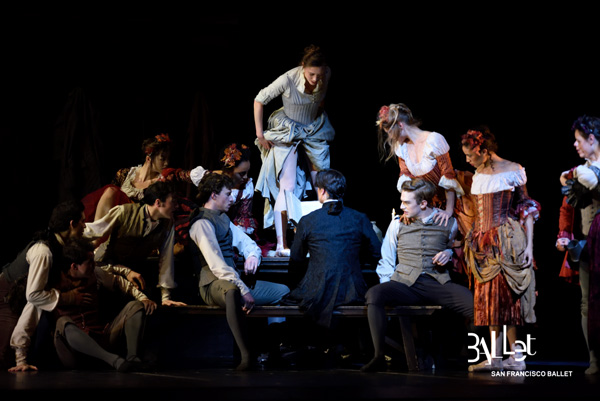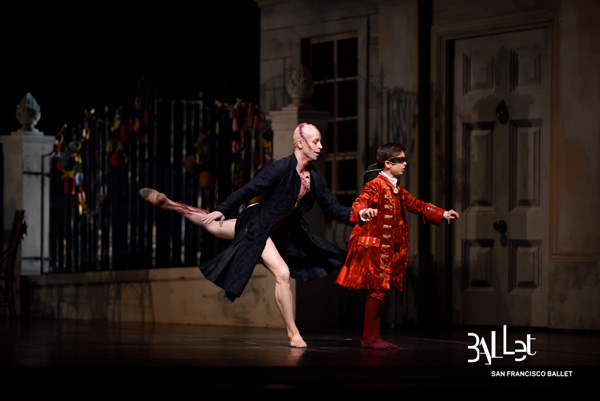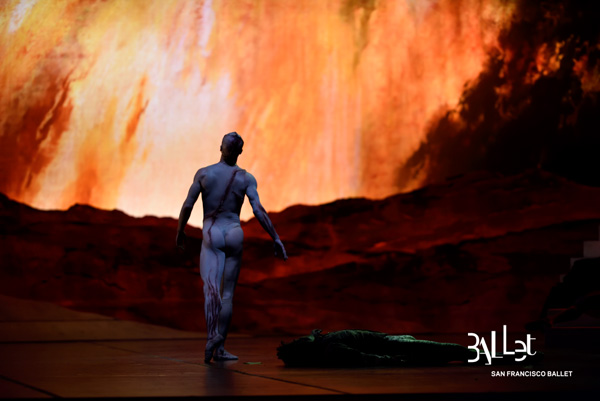|
At the heart of Mary Shelley’s timeless and provocative “Frankenstein” are multiple intersecting possibilities for
illustrating complex relationships. In Liam Scarlett’s new ballet, sadly, very few are fully explored for their expansive potential. Beautiful sets, horrifyingly gorgeous
projections, virtuosic dancing, luxurious costumes and a commissioned score could not save the evening-long work from its tragic flaws. Like Victor Frankenstein, the medical
student who created and lost control of The Creature, Scarlett fell victim to his own unwieldy creation. By becoming overly preoccupied with melodrama, manor house manners and lots
of superfluous scenes, he forgot that the story is ultimately about ambivalence toward our own creations.
During the five scenes, plus a prologue, that clutter and compete in Act I, it is not until the final moments of the very long act that the
story, and The Creature, come to life. But the spectacularly dramatic moment is lost when the curtain falls just as the audience is finally engaged mentally, physically,
emotionally, visually and aurally.
Victor Frankenstein (Joseph Walsh who was magnificent and Max Cauthorn, plucked from the corps de ballet for the role) is a nerdy kid, the son
of a doting, pregnant mother and a dominant, if affectionate father who practices medicine. Following in the path of his father, Victor is about to leave for medical school when
Scarlett’s three major subplot points collide. Daddy gives Victor a red notebook in which to record his profound thoughts and discoveries; Victor and his adopted sister
profess their passion and intention to eventually marry; and Victor’s mother dies while birthing a son, William. These occasions inspire various Downton Abbey-type scenes in
which various servants divided into echelons of status perform a lot of vapid choreography. The head housekeeper Madame Moritz (a character role played by Anita Paciotti and
Jennifer Stahl) and her daughter, Justine Moritz (danced beautifully by both Sasha de Sola and Julia Rowe) become embroiled in family matters as young Justine is constantly tempted
to penetrate the invisible line preventing her from ever fully participating because of her lower status.
 |
Victor’s arrival at medical school inspires several more superfluous scenes of medical students competing for the most
outrageous pranks. The monotony of these scenes is broken up by the introduction and near constant interruptions made by
Victor’s new best friend, Henry Clerval (danced with virtuosity and aplomb by the newly promoted principal, Angelo Greco).
Relaxing at a tavern after class, the male students attract bawdily clad young women who perform every possible movement cliché
suggesting their availability. Victor remains aloof, scribbling in his red notebook. Finally, after more student antics and a
grumpy professor dishes out some sadistic punishment, the Anatomy Theatre becomes the scene of experiments in bringing moribund flesh to life.
It is thought that Mary Shelley was inspired by actual experiments that were being conducted in London in the early
19th century when she wrote “Frankenstein.” Under a theory entitled “Galvanism,” electrical currents were used to animate
cadavers unearthed from cemeteries.
Working late at night on his own after the other students and the professor have left for the night, Victor sews together various
pieces of preserved flesh until he has molded a lump of flesh into the shape of a human and then implants a heart. Referring to his
red notebook, he makes several attempts at completing his experiment. John Macfarlane’s sets, David Finn’s lighting and
Finn Ross’s projection design ignite the stage with spectacular lightning, extravagant electrical flashes and explosions: in other
words, smoke and mirrors at their finest. The commissioned score by Lowell Liebermann provides a raucous crescendo and finally The Creature (portrayed with gusto by Vitor Luiz and
Taras Domitro) raises an arm.
As if the recess bell sounded just as a teacher finally reached the climax of her lecture, Scarlett rushes to a violent encounter
between Victor and The Creature. Victor tosses the naked and hideous creature his coat, which contains the red notebook, and
The Creature flees mere seconds after becoming animated. Whereas Mary Shelley carefully constructed a complex relationship between the two, Scarlett defaults to the monster vs
man dichotomy and hope for emotional subtlety is obscured.
The second act returns to the Frankenstein manor in Geneva and, though no less burdened by overpopulation, it highlights
the relationship between Elizabeth and Victor as Victor begins to brood about his creation. A long and sweeping pas de deux
shows Victor increasingly aloof and emotionally frozen with only occasional moments of connection with his fiancée. The Creature
lurks in the manor grounds watching hopefully for an opportunity to participate.
In a successful bid to lure Victor out of the house, The Creature leaves the red book behind cluing Victor to his worst fears that
they are not alone.
The Housekeeper’s daughter has now become Nanny to young William and she teaches him how to bow like a gentleman. In a
touching motif that will return throughout the rest of the evening, The Creature mimics the bow as if he were receiving the
lesson. A birthday party for the young boy brings out the villagers and more opportunities for court dances and also a
game of blind man’s bluff. Victor’s always mischievous pal Henry suggests leaving William alone while he’s blindfolded and The
Creature takes advantage of the opportunity to befriend him. While still blindfolded, they dance together but once the child
realizes he has been approached by a deformed monster he screams for help and in an attempt to silence the child, the monster overpowers and accidentally kills him.
 |
The third act is the most powerful as the long-awaited emotional complexity finally begins to build. All of this takes place with the
backdrop of Elizabeth and Victor’s wedding and more court dances into which The Creature weaves in and out in a lovely bit
of staging. Victor spots him and The Creature begs Victor for understanding and acceptance and also for a counterpart who he
could love as Victor loves Elizabeth. Victor refuses and a prolonged male pas de deux portrays The Creature’s attempts to
show Victor how he has learned to mimic him as evidence of how he longs to be accepted. When Victor’s fear, sorrow, guilt and
ultimate rejection fuel The Creature’s frustration, The Creature kills Victor’s father, then Elizabeth, and in the final
confrontation, rather than killing The Creature, Victor shoots himself.
In the final scene, the Creature walks slowly, all alone, upstage and away from the burning manor.

Bemoaning Scarlatt’s missed opportunities is only part of the story of this North American Premier of a co-production with the
Royal Ballet. What worked were the multimedia projections and especially the projection of a skull rotating toward the audience
on the outer curtain. It brought a deliciously creepy feeling to the San Francisco Opera House. And the brilliant dancers cannot
be blamed for the weaknesses in the narrative. Matching the brilliance of Mary Shelley, the precocious 18 year-old who wrote
the novel in 1818, turned out to be a fiendish challenge.
Photos: © Erik Tomasson
|